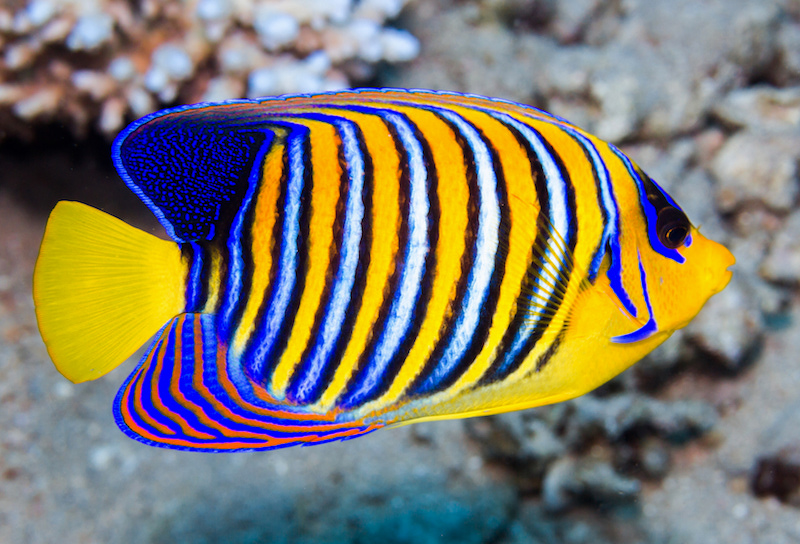Fairy Wrasses are known not only for their vibrant colors but also for their playful nature, darting and dancing through the water with an exuberance that never fails to bring a smile to our faces.
This guide will provide you everything you need to get started with your wrasse and if you already have one in your aquarium, then it will help you bring your level of expertise to a new level. So let’s dive in!
Species Summary
Known under the scientific name of Cirrhilabrus, the Fairy Wrasse is a small reef fish found in the Pacific Ocean, Indian Ocean, and Red Sea. You may also see these fish called the Solar Fairy Wrasse, Clown Fairy Wrasse, Lubbock’s Fairy Wrasse, Flame Wrasse, or Tricolor Fairy Wrasse.
In the wild, Fair Wrasses can be found at depths ranging from 3 feet to 600 feet. You’re most likely to find them congregating around tasty zooplankton. Fairy Wrasses are highly prized for their colorful appearance that has a colorfully gregarious and outgoing personality to match!
Appearance
The Fairy Wrasse is widely considered to be one of the most beautiful fish species! They are instantly recognized due to their bold colors and striking patterns. With so many color combinations possible, each one can look like a unique work of art.
While you may be distracted by this fish’s stunning coloration, do make an effort to focus on the eyes of a Fairy Wrasse if you see one in person. The cornea of the Fairy Wrasse is split into two parts to create a “double pupil” effect. Scientists believe that this unusual trait helps the cornea to act as a magnifying lens for spotting small prey.
Author Note: Fairy Wrasses also have distinctive teeth that are useful for catching and mincing the zooplankton they are so fond of eating! Each fish has three sets of canines that are split between the upper jaw and lower teeth.
Popular Species
| Common Name | Scientific Name |
| Exquisite Fairy Wrasse | Cirrhilabrus exquisitus |
| Jordan’s Wrasse | Cirrhilabrus jordani |
| Lined Fairy Wrasse | Cirrhilabrus lineatus |
| Long-Finned Fairy Wrasse | Cirrhilabrus rubriventralis |
| Lubbock’s Fairy Wrasse | Cirrhilabrus lubbocki |
| Naoko’s Fairy Wrasse | Cirrhilabrus naokoae |
| Orange-Back Fairy Wrasse | Cirrhilabrus aurantidorsalis |
| Redfin Fairy Wrasse | Cirrhilabrus rubripinnis |
| Red Velvet Fairy Wrasse | Cirrhilabrus rubrisquamis |
| Red-Headed Fairy Wrasse | Cirrhilabrus solorensis |
| Red-Margined Fairy Wrasse | Cirrhilabrus rubrimarginatus |
| Rhomboid Fairy Wrasse | Cirrhilabrus rhomboidalis |
| Rose-Veiled Fairy Wrasse | Cirrhilabrus finifenmaa |
| Scott’s Wrasse | Cirrhilabrus scottorum |
| Splendid Pintail Fairy Wrasse | Cirrhilabrus isosceles |
| Yellow-Flanked Fairy Wrasse | Cirrhilabrus cyanopleura |
| Yellow Fin Fairy Wrasse | Cirrhilabrus flavidorsalis |
| Yellow-Streaked Fairy Wrasse | Cirrhilabrus luteovittatus |
Our Favorite Fairy Wrasses
Here’s a look at stunning, vibrant Fairy Wrasses that deserve some extra attention.
- Rose-Veiled. This beautiful species was given its name due to its rosy, petal-like coloration. It holds a special place in the scientific community due to the fact that its scientific name of Cirrhilabrus finifenmaa was actually derived from the local Dhivehi language’s word for “rose.”
- Lubbock. Male Lubbock’s Fairy Wrasses are known for their vibrant yellow bodies that are marked with blue, brown, red, and white detailing. While the females have similar coloring, their markings are dull compared to males.
- Redfin. Seen abundantly in the waters off the Philippines, the Redfin is known to spend time in rubble areas and outer reefs. Despite its fiery coloration, the Redfin is known to be a peaceful fish.
- Splendid Pintail. In addition to having a name that evokes imagery of a colorful spinning pinwheel, the Splendid Pintail also delivers the same vibrant mix of colors. Found in waters stretching from Japan to the Philippines, the Splendid Pintail is known for its ornate pink, yellow, and orange coloration that delves into pastel territory. This fish will even change its colors based on its mood!
- Exquisite. The male Exquisite Fairy Wrasse has a green body with vibrant red markings. Some varieties will also exhibit vibrant orange, yellow, and blue tones.
- Naoko. Found in the Indian Ocean, Naoko’s Fairy Wrasses are known for red, white, and yellow bodies that are defined by black pectoral fins. Males will turn brilliant colors during mating to intimidate other male Fairy Wrasses.
- Orange Back. Found in small groups on the reefs off of Tomini Bay in Indonesia, the Orange-Back Fairy Wrasse is defined by an orange back with a magenta stripe that extends from top to tail. Male Orange Backs develop beautiful red “crown” markings on their heads.
Lifespan
The typical lifespan of a Fairy Wrasse is five to eight years. In areas where many predators are present, these small, easy-to-chomp fish live closer to three to five years.
Average Size
Adult Fairy Wrasses have an average size between 4 and 6 inches. With variations available in red, blue, green, yellow, orange, and beyond, these colorful fish can take on nearly all the colors of the rainbow. This is one of the reasons why enthusiasts like to collect them like gemstones!
Author Note: As a rule, male Fairy Wrasses tend to be much brighter than females. In addition, they will brighten up even more when it’s time to mate due to a “peacocking” ritual intended to scare away competing males.
Fairy Wrasse Care
While Fairy Wrasses are considered to be highly adaptable, they still require specific tank qualities and parameters in order to thrive.
Tank Size
While Fairy Wrasses max out at 6 inches, these active fish still need space to roam. The minimum recommended tank size for a Fairy Wrasse is 55 gallons. Fairy Wrasses are notorious for acting out with aggression or unwanted behaviors if they feel claustrophobic in their tanks. If you’re planning to try to house males together, the minimum recommended tank size for avoiding aggression is 300 gallons.
Water Parameters
Water temperature: 72 to 78°F
pH levels: 8.0 to 8.4
Water hardness: 8 to 12 dKH
Specific gravity: 1.020 to 1.025
Tank Setup
In the wild, deep depths keep Fairy Wrasses protected from being exposed. In tanks, their natural “flight response” that kicks in when startled puts them in danger of leaping out of the tank.
Author Note: Always use a tight tank cover when Fairy Wrasses move in! Things that cause Fairy Wrasses to startle include other fish swimming by quickly, lights turning on, lights turning off, and humans approaching the tank.
The priority for Fairy Wrasses is ample room for swimming around the tank in search of food. Unlike small burrowing fish, Fairy Wrasses don’t require sand beds. Just be sure to add some live rock to provide hiding spots that keep this fish feeling safe and protected. Fairy Wrasses also appreciate some saltwater tank plants.
Recommended Plants:
- Mermaid’s fan
- Green finger plant
- Sea lettuce
- Spaghetti algae
- Dragon’s tongue algae
Lighting
Lighting is a hot topic with Fairy Wrasses because needs vary greatly within the species. While some Fairy Wrasse varieties prefer shallow waters, others like deep depths. This is part of the adaptable nature of Fairy Wrasses that allows them to thrive in so many different reef locations around the globe.
If you have a deep diver, dim lighting is recommended. Fans of shallow water will prefer brighter lighting.
Filtration
In addition to requiring large tanks, Fairy Wrasses require clean tanks. Filtration is also important for keeping this fish healthy and content. A canister filter (the Fluval FX4 could be an option) is recommended for keeping Fairy Wrasses because it provides more power than an internal filter. Try to follow the rule of finding a filter capable of cleaning four times the tank’s water volume.
Acclimation
Like all fish, Fairy Wrasses should be kept in quarantine for a few days prior to being introduced to a tank with existing fish. This will prevent your new fish from spreading potentially fatal diseases or parasites to other fish.
Author Note: If you are planning to house Fairy Wrasses with crustaceans, it’s recommended that you add the Fairy Wrasses last to avoid aggression that might come from the fish feeling territorial. Territorial Fairy Wrasses may possibly try to feast on crustaceans.
Due to the fact that Fairy Wrasses will startle easily in the presence of fast-moving fish, it’s also advised that you put your Fairy Wrasse in the tank before adding any active fish. This will give the Fairy Wrasse the ability to acclimate to the environment without startling. When startled, it’s very common for a Fairy Wrasse to become injured by slamming up against the tank.
Are Fairy Wrasse Reef Safe?
Fairy Wrasses are considered extremely safe for reefs. Their heavy preference for zooplankton means that they will leave corals alone.
Common Possible Diseases & Prevention
While Fairy Wrasses aren’t necessarily more susceptible to disease than other fish species, there are three big illnesses to know about when keeping these fish.
Fin rot. This is a common disease affecting both freshwater and saltwater fish, fin rot is characterized by color changes, inflammation, and fraying of the fins and tail. The infection that causes fin rot may also reach the base of the body.
Pop-eye. This occurs when an infection causes fluid to build up either in the eye or behind the eye. It’s usually obvious when your fish has pop-eye because you will notice bubbles in the skin surrounding the eye. Over time, the eye may eventually bulge out of the socket. Many fish go blind after contracting pop-eye.
Ich (white spot). This is caused by an external parasite. You’ll know that your fish has contracted ich if you notice white spots on the gills and skin. Veterinarians can often prescribe treatments for ich.
Food & Diet
Fairy Wrasses in the wild will eat zooplankton every chance they get! Some keepers will actually attach a refugium for zooplankton to a tank in order to keep Fairy Wrasses satisfied. However, this is not a requirement. In fact, Fairy Wrasses aren’t known to be picky about their diets.
Both frozen and live proteins are perfectly fine. Enriched brine shrimp can be especially nutritious for Fairy Wrasses. The ideal diet for a captive Fairy Wrasse will consist of large amounts of live food with some flake food thrown into the mix.
Behavior & Temperament
Fairy Wrasses are definitely aware of their small size. As a result, they are expert hiders that will dart into the nearest rocky niche in order to remain hidden. As diurnal creatures, they are active most of the day. At night, they spin their bodies into little mucus cocoons to keep their scent concealed.
While generally considered to be docile, Fairy Wrasses will battle it out with fish of similar size over territory. Fights will generally last until both fish have tattered fins and scales.
Author Note: Placing your Fairy Wrasse in a tank that’s large enough to provide room to swim around freely without bumping into other fish is the best way to keep aggression out of these fish!

Fairy Wrasse Tank Mates & Predators
The general rule with Fairy Wrasses is that they get along with almost any other fish as long as it’s not a fellow Fairy Wrasse. It’s even better if you can pair a Fairy Wrasse with fish that aren’t fellow carnivores. The top tank mates for Fairy Wrasses include:
Fairy Wrasses don’t do well with predatory or competitive tank mates. While aggressive fish can make snacks out of Fairy Wrasses, competitive tank mates can easily starve them out. If the Fairy Wrasse is the more aggressive competitor, your other fish could be the one to get starved out. Tank mates to skip include:
Breeding
All Fairy Wrasses are born female. When a dominant male in a group dies, the largest female will undergo a sex change to become a male. At spawning time, the dominant male will flash stunning scale colors as he swims through groups of females. After choosing a female, he will charge at her in all his colorful and metallic splendor! During a looping sequence that can be observed easily by onlookers in the water, eggs and sperm are released.
Breeding Fairy Wrasses in captivity is extremely difficult because it requires keeping one male with a “harem” of female Fairy Wrasses, therefore a very large aquarium!
In Closing
We hope this guide has sparked your curiosity about fairy wrasses. These captivating fish offer so much more than just their striking colors. With their delicate yet resilient nature, fairy wrasses can thrive in a well-maintained saltwater aquarium, adding a touch of magic and wonder to your underwater world.
If you have any questions please do not hesitate in reaching out to us and for more knowledge try our saltwater fish care guides. Lastly, if you are sharing photos of your amazing fairy wrasse in social media don’t forget to tag us on Facebook!



